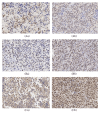Immunohistochemical Study of NR2C2, BTG2, TBX19, and CDK2 Expression in 31 Paired Primary/Recurrent Nonfunctioning Pituitary Adenomas
- PMID: 31223310
- PMCID: PMC6541973
- DOI: 10.1155/2019/5731639
Immunohistochemical Study of NR2C2, BTG2, TBX19, and CDK2 Expression in 31 Paired Primary/Recurrent Nonfunctioning Pituitary Adenomas
Abstract
This study investigated potential markers for predicting nonfunctioning pituitary adenoma (NFPA) invasion and recurrence by high-throughput tissue microarray analyses. We retrospectively studied two groups of patients: 60 nonrecurrent NFPA cases that included noninvasion and invasion subtypes and 43 recurrent cases that included primary NFPA. A total of 31 paired patient samples were evaluated (12 patients with one surgery and 31 who had undergone two operations, with both tumors analyzed). Expressions of nuclear receptor subfamily 2 group C member 2 (NR2C2), B cell translocation gene 2, T-box-19 (TBX19), and cyclin-dependent kinase 2 (CDK2) in surgically resected specimens were assessed by immunohistochemistry. The relationships between marker expression and clinical characteristics including age, sex, tumor volume, and follow-up time were analyzed. Tumor volume and invasion as well as follow-up time were significantly associated with invasion and recurrence (P < 0.01). Of the 60 nonrecurrent samples, 15/41 and 13/19 showed high NR2C2 expression in the noninvasion and invasion groups, respectively (χ 2 =5.287, P = 0.021). NR2C2 was also overexpressed in 43 primary recurrent cases (χ 2 =5.433, P = 0.02), whereas CDK2 (χ 2 = 11.242, P = 0.001) and TBX19 (χ 2 = 4.875, P = 0.027) were downregulated. In the 31 paired samples, NR2C2 was more highly expressed in the recurrent as compared to the primary tumor. High NR2C2 expression was associated with NFPA invasion, recurrence, and progression, while TBX19 and CDK2 were associated with NFPA recurrence.
Figures


Similar articles
-
Analysis of Ki67, HMGA1, MDM2, and RB expression in nonfunctioning pituitary adenomas.J Neurooncol. 2017 Apr;132(2):199-206. doi: 10.1007/s11060-016-2365-9. Epub 2017 Mar 2. J Neurooncol. 2017. PMID: 28255749 Free PMC article.
-
Expression of Ki-67, PTTG1, FGFR4, and SSTR 2, 3, and 5 in nonfunctioning pituitary adenomas: a high throughput TMA, immunohistochemical study.J Clin Endocrinol Metab. 2012 May;97(5):1745-51. doi: 10.1210/jc.2011-3163. Epub 2012 Mar 14. J Clin Endocrinol Metab. 2012. PMID: 22419713
-
Association of TGF-β1 and WIF1 Expression with 36 Paired Primary/Recurrent Nonfunctioning Pituitary Adenomas: A High-Throughput Tissue Microarrays Immunohistochemical Study.World Neurosurg. 2018 Nov;119:e23-e31. doi: 10.1016/j.wneu.2018.06.154. Epub 2018 Jun 30. World Neurosurg. 2018. PMID: 29966778
-
Nonfunctioning adenomas of the pituitary.Metabolism. 1996 Aug;45(8 Suppl 1):80-2. doi: 10.1016/s0026-0495(96)90090-6. Metabolism. 1996. PMID: 8769390 Review.
-
Recurrent non-functioning pituitary adenomas: a review on the new pathological classification, management guidelines and treatment options.Clin Transl Oncol. 2018 Oct;20(10):1233-1245. doi: 10.1007/s12094-018-1868-6. Epub 2018 Apr 5. Clin Transl Oncol. 2018. PMID: 29623588 Review.
Cited by
-
Predictors of progression after surgery in non-functioning pituitary macroadenomas: a Spanish multicenter study.J Endocrinol Invest. 2025 Aug 8. doi: 10.1007/s40618-025-02674-6. Online ahead of print. J Endocrinol Invest. 2025. PMID: 40779234
-
The Differential Expression of Long Noncoding RNAs in Type 2 Diabetes Mellitus and Latent Autoimmune Diabetes in Adults.Int J Endocrinol. 2020 Feb 19;2020:9235329. doi: 10.1155/2020/9235329. eCollection 2020. Int J Endocrinol. 2020. PMID: 32148491 Free PMC article.
-
Pituitary Adenomas and Invasiveness from Anatomo-Surgical, Radiological, and Histological Perspectives: A Systematic Literature Review.Cancers (Basel). 2019 Dec 4;11(12):1936. doi: 10.3390/cancers11121936. Cancers (Basel). 2019. PMID: 31817110 Free PMC article. Review.
-
Nomogram predictive model of post-operative recurrence in non-functioning pituitary adenoma.Gland Surg. 2021 Feb;10(2):807-815. doi: 10.21037/gs-21-47. Gland Surg. 2021. PMID: 33708562 Free PMC article.
-
Non-functioning pituitary macroadenoma following surgery: long-term outcomes and development of an optimal follow-up strategy.Front Surg. 2023 Jul 12;10:1129387. doi: 10.3389/fsurg.2023.1129387. eCollection 2023. Front Surg. 2023. PMID: 37501881 Free PMC article.
References
Grants and funding
LinkOut - more resources
Full Text Sources

